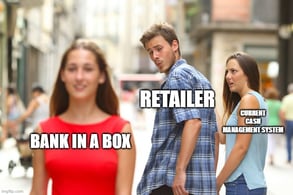New Tax Laws Push Gig Workers to Cash
While the big news is still pushing cash-free stores and stories about the imminent “death of cash” (Since the ‘80s. Yep, really imminent.). Most retailers know the truth. Cash, just like credit and debit card fees, is an essential burden. After all, Americans use cash for 20% or more of their transactions, especially for items $25 or less. And that percentage takes a dramatic up-tick for households making $75,000 per year or less.
But even more important is the surprising return to cash US retailers are seeing in 2023. As the economy and inflation have heated up, consumers have increasingly turned to “cash-stuffing”, using physical currency to help them manage their budgets. Recent surveys from Credit Karma and The Harris Poll show over half (53%) of US adults are using cash more than they did in 2022. That’s on top of the cash use increase we saw after 2019 as reported by the Federal Reserve.
And now, to make matters worse, new tax laws are steadily pushing Gig Economy workers to do the unthinkable – go cash only.
Gig workers can't affect cash use that much, can they?

The short answer is yes. There are over 14 million adults working gig jobs. Nearly half of those are people working side jobs on top of their full-time positions. Gig work is the main source of income for less than one-third of workers (31%). This means their full-time position pays for their health insurance, rent, and utilities.
That gig job? It’s for groceries, gas, vacation savings, entertainment, or – more often than not - just making ends meet as prices for essentials continue to ratchet higher.
Thirty percent of Gen Z adults have worked or currently work gig jobs while 18% of Millennials have answered the call. And it’s not just low-income households working side hustles, either. Consumers from homes that are technically considered middle- or upper-class have also taken advantage of gig work opportunities.
And it can be a pretty decent chunk of money, too. Gig workers bring in anywhere between $1k to over $11k per month.
Why cash?
Everyone knows the easiest way to get paid for one-off jobs is through a payment app. Most gig workers rely heavily on Venmo, Cash App, PayPal, or Zelle. For the average person trying to make a little extra money to cover gaps, these applications have offered a fast, easy way to pull in spending money.
Even better, a lot of property owners, daycares, stores, and online businesses accept payments from these apps, too. If that’s the case, the money might not even touch a gig worker’s bank account before it heads right back out to pay for things.
This brings us to the “new tax legislation” dilemma.
BEFORE the new payment app rule, the apps only reported activity on accounts that generated $20,000+ over the course of 200 or more transactions. Anyone with an account pulling in that much activity AND money would get a 1099-K form. You get a form, you have to claim the money because the IRS definitely knows about it.
NOW a single transaction of $600 or more will flag the account for reporting to the IRS and generation of a 1099-K form.
You sell a used couch online for $600 and receive payment on Venmo? You get a 1099-K. Now, you sell something used at a loss like that, and there is a way to write it off. But you have to admit it’s a pain.
Now imagine you were making around $600 a month in extra income from your side hustle. But that money, all of it, went right back out the door every month in rent. And now you suddenly have extra paperwork come tax time. Worst case scenario(s) you get bumped into a higher tax bracket, eliminate your refund, or have to pay.
The answer? Secure, safe, simple…cash.
So...what? Expect more cash?
You can pretty well bet any gig worker who can push a cash-only or cash-preferred model is going to go that route. Lawn care companies, home repair contractors, moving companies, crafters, woodworkers, restaurant pop-ups…the list goes on.
 And then comes the payment flip. Before it was gig money going to rent, daycare, vacations, and online purchases and debit for everything else. Flip that and reverse as cash now covers all of the in-person purchases like groceries, gas, entertainment, and other everyday essentials.
And then comes the payment flip. Before it was gig money going to rent, daycare, vacations, and online purchases and debit for everything else. Flip that and reverse as cash now covers all of the in-person purchases like groceries, gas, entertainment, and other everyday essentials.
The good news is, more customers might have to visit in-store ATMs to get cash to pay for things. The bad news is, retailers might be looking at an even bigger spike in cash payments than they anticipated. Fortunately, there is an easy, affordable way to get ahead of the game – without the type of expense retailers expect from other cash management systems.
Cash Depot’s BANK IN A BOX program combines all of the best, most desirable features of cash management with an added dose of innovation – that not only off-set cost, but brings in added revenue.
Discover how BANK IN A BOX can help your business manage its cash better - click here.
TLDR: To avoid taxes, gig workers take cash and use it in stores instead of credit or debit. Retailers left to deal with additional cash.




